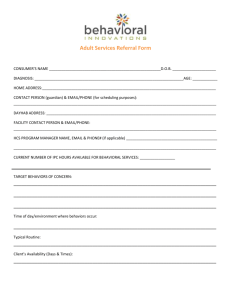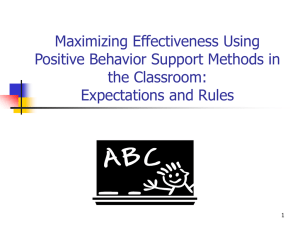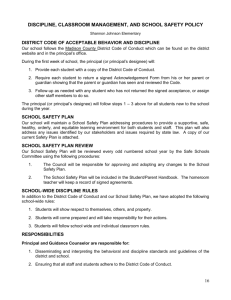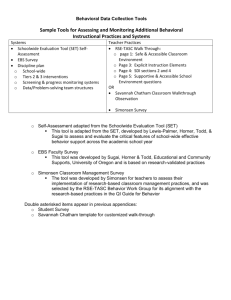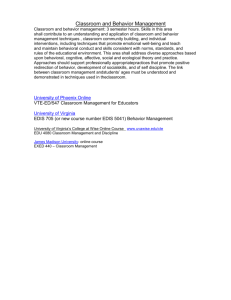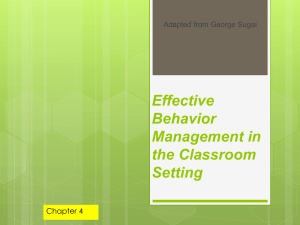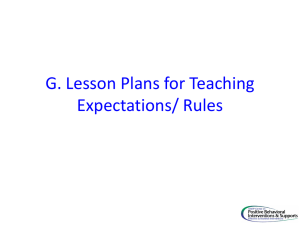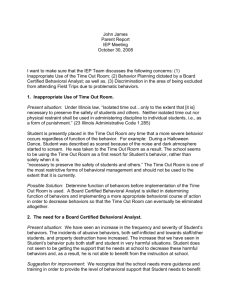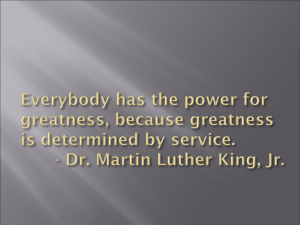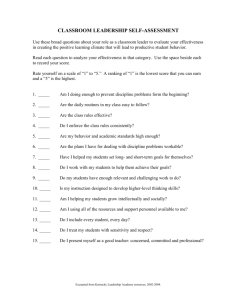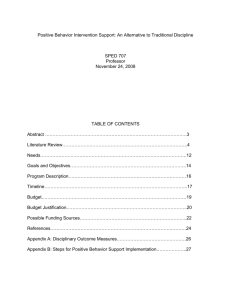Component 1: Statement of Purpose
advertisement
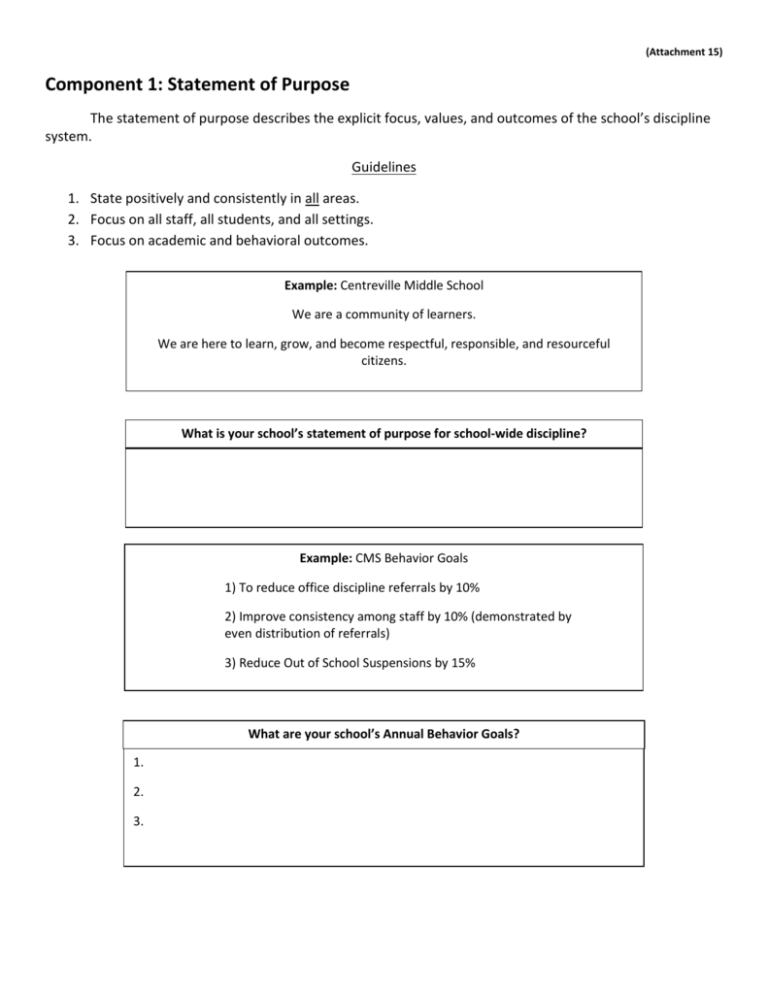
(Attachment 15) Component 1: Statement of Purpose The statement of purpose describes the explicit focus, values, and outcomes of the school’s discipline system. Guidelines 1. State positively and consistently in all areas. 2. Focus on all staff, all students, and all settings. 3. Focus on academic and behavioral outcomes. Example: Centreville Middle School We are a community of learners. We are here to learn, grow, and become respectful, responsible, and resourceful citizens. What is your school’s statement of purpose for school-wide discipline? Example: CMS Behavior Goals 1) To reduce office discipline referrals by 10% 2) Improve consistency among staff by 10% (demonstrated by even distribution of referrals) 3) Reduce Out of School Suspensions by 15% What are your school’s Annual Behavior Goals? 1. 2. 3. COMPONENT 2: Clearly defined positively stated behavioral expectations Behavioral expectations are rules that provide a focus for consistent communications, and support an efficient verbal community in which all members have clear understandings of what is expected of themselves and others. “Rules on Rules” 1. 2. 3. 4. Expectations are applied to all students and all adults, and in all settings. No more than 3 rules/expectations should be specified. All rules/expectations should be stated positively. All rules/expectations should be compromised of a few common words. Example At Centreville Middle School, we are Respectful Responsible Resourceful What are the stated school-wide behavioral expectations in your school? 1. 2. 3. Component 3: How do we teach behavioral expectations? Area specific (classroom, hall, bus, etc…) Example, Non-Example, Example Re-Teach as needed (August, January) School-wide behavioral expectations are taught in the same manner as academic skills. a) teach/model b) guided practice c) monitor and positively reinforce it in natural context Guidelines 1. Develop positively stated behavioral definition for each behavioral expectation. 2. Specify observable behavior examples for each expectation in typical school settings. 3. Use positive, negative, and then only positive behavior examples (e.g. dress code, being on-time, getting on task). 4. Teach in natural settings. 5. Practice in controlled and natural settings. 6. Provide prompts (reminders and pre-corrections) for display of behaviors in natural context and settings. 7. Provide feedback (corrections and positive acknowledgements) for displays of behaviors in natural contexts and settings. 8. Continuously evaluate effectiveness, efficiency, and relevance of instruction and curriculum. Component 4: Procedures for Encouraging Behavioral Expectations If newly taught and acquired behaviors are to be strengthened, occur more often in the future, and be sustainable over time, students must receive positive feedback/acknowledgements for their displays of those behaviors. Guidelines for Encouraging Student Behaviors 1. Move from… a. External to internal b. Frequent to infrequent c. Predictable to unpredictable d. Tangible to social 2. Individualize as much as possible to accommodate individual differences and diversity 3. Build on person-to-person relationships 4. Strive for a ratio of 6 – 8 positive interactions for every 1 negative interaction 5. Label the behavior for which the positive acknowledgement is intended; for example, “Thank you for waiting your turn.” Positive Reinforcement Procedures What When By Whom How Often How Many Where Component 5: Continuum of Procedures for Discouraging Problem Behavior Procedures for responding to problem behaviors should be designed to communicate to and teach students, staff, and family members what behaviors represent violations of school-wide behavioral expectations. Severity, consequences, and behavioral supports should be indicated. Guidelines for Discouraging Problem Behaviors 1. Develop clear distinctions between problem behaviors that are managed by staff/classroom teachers and by office/administrative staff. 2. Develop an office discipline referral, behavior incident recording sheet, or tracking system that provides minimum information about… a. Who violated rule (name, grade) b. Who observed & responded to the rule violation c. When (day & time) the rule violation occurred d. Who else was involved in the problem situation e. Where the rule violation occurred f. What was the possible motivation or purpose of the problem behavior g. What school-wide behavioral expectation was violated 3. Define and teach directly rule violators… a. In observable terms b. With examples c. Along a continuum of increasing severity 4. Establish procedures for preventing and responding to students with repeated rule violations. a. Pre-referral intervention or behavior support team b. Data-decision rule for initiating positive behavior supports c. Pre-correction intervention to prevent future occurrences of problem behavior d. Formal procedures for teaching, practicing, and reinforcing positive, pro-social behaviors to replace problem behaviors e. Adult mentor/advocate for support 5. Assign corrective consequences based on the purpose/motivation (function) of the problem behavior. Always remember consequences are designed to prevent future inappropriate behavior. a. Behavior to access/ get attention, activities, objects, etc… b. Behavior to escape/avoid attention, activities, tasks, etc… What Continuum of Procedures for Discouraging Problem Behaviors Are in Place in Your School? Positive Reinforcement Procedures Level Minor Major District Definition Examples Procedures Component 6: Procedures for Record Keeping and Decision Making Demonstrate data to staff regularly 2D graphs by students, staff, day, month, year To ensure the effective, efficient, relevant, and sustained implementation of a school-wide discipline system, school staff members must receive information that is accurate, timely, and easily available to guide decision-making. In general, a record-keeping and decision-making system must have… a. Structures and routines for data collection b. Mechanisms for data entry, storage, and manipulation, and c. Procedures and routines for review and analysis of data General Decision-Making Considerations In general, schools regularly must consider, for example, the following questions: 1. What practices should we adopt to address our needs? a. What evidence supports the effectiveness of this practice? b. What evidence suggests that this practice is appropriate for our school? Can this practice be modified for the unique features of our school? c. What can we learn from other schools that have used this practice? 2. Is adequate progress being made (effectiveness)? 3. Are current practices being implemented with high fidelity or accuracy (efficiency)? 4. What elements of a practice can be eliminated and still maintain the same level of progress (efficiency)? 5. What practices should be modified to improve progress (effectiveness)? 6. Do students, staff members, parents, and/or community members support the use of current practices and their impact? Guidelines Record keeping and data decision-making systems must be effective, efficient, and relevant. 1. Develop data collection procedures that are integrated into typical routines (e.g., office discipline referrals, attendance rolls, behavior incident reports). 2. Regularly assess the accuracy of data collection procedures 3. Limit data collection to information that answers important student, classroom, and school questions. 4. Establish specific structures and routines for staff members to receive weekly/monthly data reports about the status of school-wide discipline. 5. Precede all decision-making efforts with “What do our data indicate?” 6. Use teams to review data and develop data-based action plans. 7. Establish specific data-decision rules to guide review of data. 8. Develop data storage and management procedures that… a. Can be managed accurately by 2-3 staff members at any time. b. Consume no more than 1% of the time available in a school day. c. Can summarize data in an efficiently, timely, and graphically informative manner. Sample Teacher Discipline Data Documentation Form/steps Student Name: __________________________________ Date: _____/_____/_____ Teacher Name: __________________________________ Period: ____ Grade: ____ 1. Student Conference Date: _____/_____/_____ Facts of Incident: _____________________________________________________ _______________________________________________________________________ _______________________________________________________________________ 2. Student Conference (Do I need to call your parents?) Date: _____/_____/_____ Facts of Incident: _______________________________________________________ ________________________________________________________________________ ________________________________________________________________________ 3. Parent Phone Call Date: _____/_____/_____ Facts of Incident: _______________________________________________________ ________________________________________________________________________ ________________________________________________________________________ 4. Parent Conference Date: _____/_____/_____ Facts of Incident: _______________________________________________________ ________________________________________________________________________ ________________________________________________________________________ 5. Referral to Office Date: _____/_____/_____ Facts of Incident: _______________________________________________________ ________________________________________________________________________ ________________________________________________________________________
